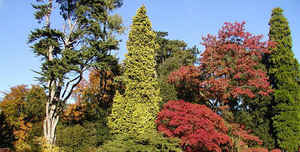Kansas State Tree
Cottonwood

(Salicaceae Populus deltoides)
Adopted on March 23, 1937.
Kansas House Bill No. 113, introduced by State Representative Relihan, led to the cottonwood being adopted as the official state tree of Kansas by an act of the Kansas Legislature, calling it the "pioneer tree of the prairie," approved on March 23, 1937. I
The Kansas legislation did not specify a particular variety of cottonwood and there hasn't always been agreement about the classification of cottonwoods that do grow in Kansas.
Eastern cottonwood (typical) (Populus deltoides var. deltoides) is also called southern cottonwood, common cottowood, Carolina poplar, plains cottonwood, eastern poplar, necklace poplar, and a`lamo.
Kansas State Tree: Cottonwood

Eastern cottonwood, (Salicaceae Populus deltoides,) one of the largest eastern hardwoods, is short-lived but the fastest-growing commercial forest species in North America.
It grows best on moist well-drained sands or silts near streams, often in pure stands. The lightweight, rather soft wood is used primarily for core stock in manufacturing furniture and for pulpwood. Eastern cottonwood is one of the few hardwood species that is planted and grown specifically for these purposes.
Besides the typical eastern variety (var. deltoides), there is a western variety, plains cottonwood (var. occidentalis). Its leaves, more broad than long, are slightly smaller and more coarsely toothed than the typical variety.

Populus deltoides has been referred to as the eastern cottonwood. But, some botanists recognize two variations of Populus deltoides, var. deltoides commonly called the eastern cottonwood and var. occidentalis Rydb. commonly referred to as the plains cottonwood.
Both varieties grow in Kansas though only the variation defined as occidentalis is considered native to the state by the USDA's National Resources Conservation Service, PLANTS database. But, the Great Plains Nature Center in Wichita, Kansas describes the state tree as the eastern cottonwood or generically, (Populus deltoides). Either or both varieties can probably be considered official.)
Identification of the Kansas Cottonwood
- Size: 80 - 100 feet with 40 - 60 ft. Spread
- Growth: Rapid; moderate to long life span.
- Leaf: Alternate, simple, pinnately veined, 3 to 6 inches long, triangular (deltoid) in shape with a crenate/serrate margin. The petiole is flattened and glands are present at the top of the petiole.
- Flower: Dioecious, male and female as pendulous catkins, appearing before the leaves.
- Fruit: Cottony seeds, 1/4 inch long borne in a dehiscent capsule. Maturing over summer.
- Twig: Stout, somewhat angled and yellowish. Buds are 3/4 inch long, covered with several brown, resinous scales. Has a bitter aspirin taste.
- Bark: Smooth, gray to yellow-green when young. Later turning gray with thick ridges and deep furrows.
- Form: A large tree with a clear bole and an open spreading crown resulting in a somewhat vase-shaped form.
Kansas House Bill No. 113
House Bill No. 113, introduced by State Representative Relihan, started the official process that led to the cottonwood being adopted
as the official state tree of Kansas by an act of the Kansas Legislature, approved on March 23, 1937.
Chapter 318
Designating the Cottonwood Tree as the official state tree
HOUSE BILL NO. 113
AN ACT designating the cottonwood tree as the official state tree of Kansas.
WHEREAS, If the full truth were known, it might honestly be said that the successful growth of the cottonwood grove on the homestead was often the
determining factor in the decision of the homesteader to "stick it out until he could prove up on his claim"; and
WHEREAS the cottonwood tree can rightfully be called "the pioneer tree of Kansas"; Now therefore,
Be it enacted by the Legislature of the State of Kansas:
Section 1. That the tree be known as the cottonwood is hereby designated and declared to be the official tree of the state of Kansas.
Sec. 2. This act shall take effect and be in force from and after its publication in the statute book.
Approved March 23, 1937.
Kansas Law
The law designating the cottonwood as the official Kansas state tree is found in the Kansas General Statutes, Chapter 73 (SOLDIERS, SAILORS AND PATRIOTIC EMBLEMS) Article 9 (STATE TREE) Section 73-1001.
Chapter 73.--SOLDIERS, SAILORS AND PATRIOTIC EMBLEMS.
Article 10.--STATE TREE.
SECTION 73-1001.
73-1001. Designation. The tree known as the cottonwood is hereby designated and declared to be the official tree of the state of Kansas.
History: L. 1937, ch. 318, § 1; June 30.
Taxonomic Hierarchy: Eastern Cottonwood
Kingdom: Plantae - Plants
Subkingdom: Tracheobionta - Vascular plants
Superdivision: Spermatophyta - Seed plants
Division: Magnoliophyta - Flowering plants
Class: Magnoliopsida - Dicotyledons
Subclass: Dilleniidae
Order: Salicales
Family: Salicaceae - Willow family
Genus: Populus L. - cottonwood
Species: Populus deltoides W. Bartram ex Marshall - eastern cottonwood








